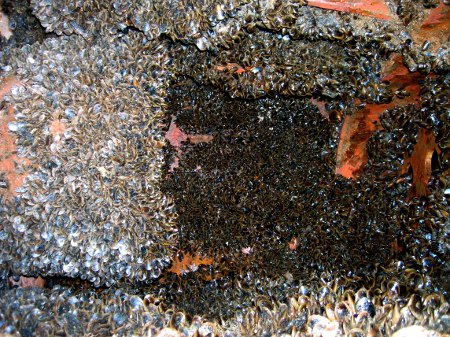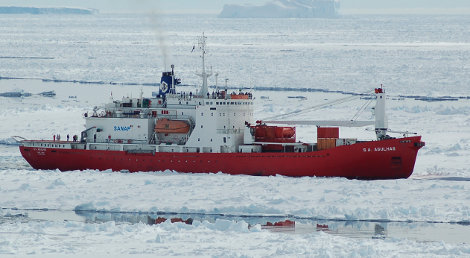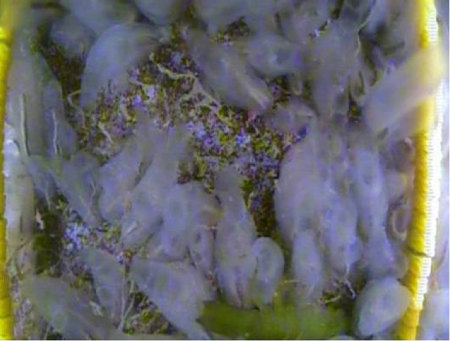
|
Published: 17 October 2011
Preventing a marine invasion in the sub-Antarctic
As the climate warms and visitor numbers to the Antarctic and sub-Antarctic increase, so does the threat of an invasion by marine species carried to the region on resupply vessels and tourist ships.

|
|
The Mediterranean mussel Mytilus galloprovincialis in the sea chests of the S.A. Agulhas, the hull of which was monitored over two years by a remotely controlled video camera. Credit:
Jennifer Lee
|
Speaking at the recent Third International Forum on the Sub-Antarctic held in Hobart in August, Dr Jennifer Lee – a postdoctoral fellow at the Centre for Invasion Biology, Stellenbosch University, South Africa – said preventative action was essential.
‘It’s difficult, expensive and sometimes impossible to eradicate species in a terrestrial habitat and there’s never been a successful eradication in a marine habitat,’ said Dr Lee. ‘There is no cure; prevention really is the only way.’
Dr Lee and her colleagues, in association with the South African National Antarctic program, investigated the risks of transporting alien species into the sub-Antarctic by the two most likely means – on ships’ hulls and in sea chests.
The team examined the development of hull-fouling communities on the South African resupply vessel S.A. Agulhas by surveying the ship’s hull before and after every voyage over two years, using a remotely operated vehicle fitted with a moveable camera and lights.
Researchers took continuous video footage of 10 transects of the hull, each of which were two metres wide and four metres apart. They observed a range of organisms taking up residence, including various types of algae, small crustaceans, sea squirts and mussels.

|
|
The South African Antarctic resupply vessel S.A. Agulhas. Credit:
Jennifer Lee
|
‘The most profound impact on fouling of the hull occurred after the vessel travelled through sea ice. It went from having about 11 per cent fouling cover to zero. So, the risk of transporting species into the Antarctic was very low,’ said Dr Lee.
‘But the sea ice removed the anti-fouling coating from the ship’s hull, which enabled a more rapid accumulation of organisms when the vessel was in port. Then, when the vessel travelled through the open ocean, almost intact communities were transported from Cape Town to the sub-Antarctic islands.’
The team was also shocked to discover the favourable living conditions provided by sea chests. Sea chests are covered recesses into ships’ hulls where water is taken onboard for engine cooling. They have a constant flow of water through them and are protected from heavy seas and ice scour.
‘The sea chest of the Agulhas was full of a globally invasive bivalve species, the Mediterranean mussel (Mytilus galloprovincialis), many samples of which were over two years old. This means they had survived transport to Gough and Marion islands and to colder waters in Antarctica,’ said Dr Lee.
A review of the scientific literature indicated that most of the organisms present on the Agulhas’ hull or in its sea chest were physiologically capable of surviving in the sub-Antarctic environment, and some in even colder water. However, Dr Lee said more information on the temperature tolerance of a wider range of fouling species was required before a full risk assessment could be made.
More information is also needed on how vessel type and size affects hull fouling.
‘Most research has been done on medium-sized research ships, but small yachts and larger tourist ships could be affected differently,’ she said.
‘And, we don’t know how the species composition of the home port affects the fouling community composition. Most work on this has been done in Australia or South Africa, but many vessels leave from Ushuaia in South America.’
Dr Lee says new technologies promise to provide cost-effective strategies for dealing with hull fouling, such as the Hull Identification System for Marine Autonomous Robots (HISMAR). Developed in the European Union, the HISMAR attaches magnetically to ships’ hulls and removes light-to-medium fouling using high-pressure water jets. The water is filtered to remove biological and chemical contaminants before release.
‘This sort of technology may be less expensive and time consuming than frequent dry docking or using divers to clean the hull,’ said Dr Lee.
‘By adopting a more precautionary approach to hull fouling, we can reduce the threat of a sub-Antarctic marine invasion while further research is conducted to better define the risks.’

|
|
Image captured from the video camera of one of the organisms fouling the monitored hull: the invasive sea squirt Ciona intestinalis. Credit:
Jennifer Lee
|
This article is reproduced courtesy of the Australian Antarctic Division.
More information
Lee JE and Chown SL (2009). Temporal development of hull-fouling assemblages associated with an Antarctic supply vessel. Marine Ecology Progress Series 386, 97–105.



